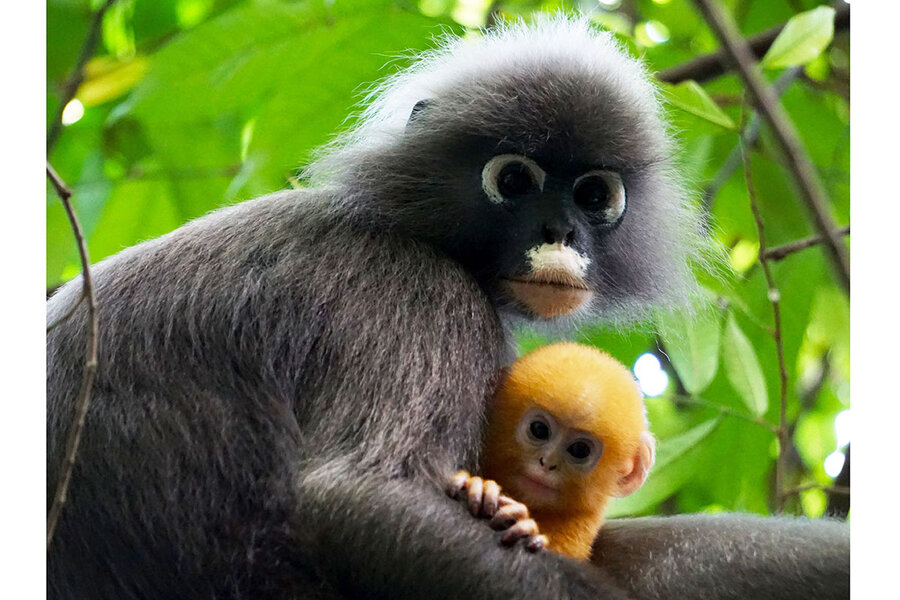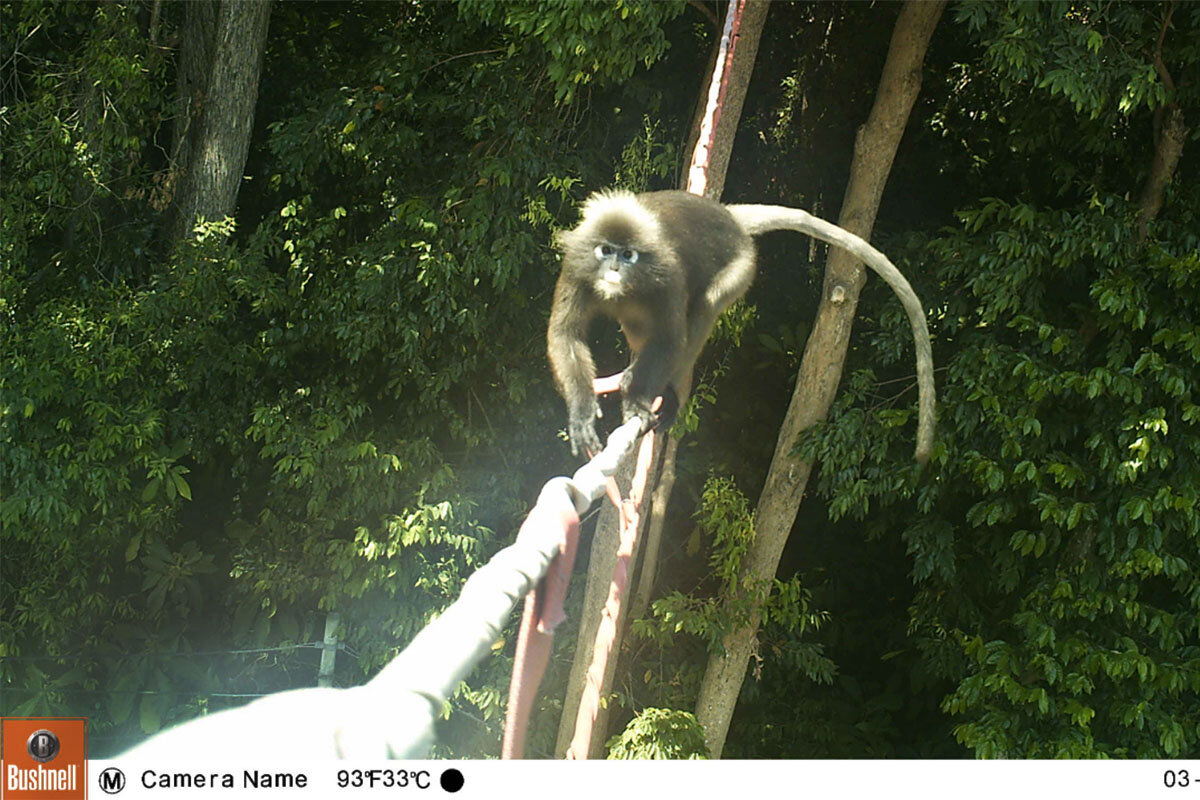Roads broke up an endangered monkey's habitat. Can bridges fix it?
Loading...
| Teluk Bahang, Malaysia
High up on the hill road leading to Malaysia’s Penang National Park, cars and motorbikes zip by the forest at great speeds. Some 40 feet above a particularly busy turn, almost invisible to the casual observer, hangs an aerial bridge made of rope and recycled fire hoses. It’s easy to miss, but this humble crossing has the power to save lives.
Dusky langur lives, that is.
Once abundant all over Peninsular Malaysia, these endangered primates – also known as dusky leaf monkeys – have wide, white-circled eyes that make them look serious and spectacled, and they are critical to the local ecosystem. Their numbers are decreasing partly because of their own movements; dusky langurs travel between treetops by jumping from branch to branch with total abandon, but when tree coverage is thin, they resort to using electrical cables or scurrying across the ground, often leading to electrocution and fatal collisions with motorists. The Langur Project Penang (LPP), a citizen science project founded by wildlife researcher Jo Leen Yap, counted seven instances of roadkill on this half-mile stretch of Teluk Bahang road before the bridge went up. Since then, thousands of animals have crossed the road without incident.
Why We Wrote This
In Malaysia’s Penang forests and beyond, novel road crossings are helping humans and wildlife coexist peacefully.
This aerial crossing – the first of its kind in Malaysia – is part of a global trend of conservationists using bridges, tunnels, and other passageways to address habitat fragmentation caused by human development.
“As we humans encroach more and more into the natural world, we also need to step up and take responsibility for the welfare of our wildlife,” says Allen Tan, managing director of The Habitat Penang Hill, a rainforest conservation center that has awarded research grants to Ms. Yap through its charitable foundation. “Jo Leen’s bridge is a great step in that direction.”
Langur love
As a Penang local, Ms. Yap considers dusky langurs an important part of her natural heritage. Cute looks aside, the shy species serves as an important agent of seed dispersal, helping regenerate forests.
She founded LPP in 2016 with the goal of ensuring future generations will get to see and enjoy the dusky langurs, just as she does. Her team of volunteers – mainly local community members and undergraduate students from the Universiti Sains Malaysia, where Ms. Yap is getting her Ph.D. – focuses on researching dusky langur behavior, as well as public outreach and education. Locals are encouraged to report dusky langur sightings, including any signs of distress or road accidents, through LPP’s social media channels.
The group named its urban canopy bridge Ah Lai’s Crossing, after the first alpha male langur that LPP tracked for an extended period of time. Ms. Yap says it took months of patience to get close to him. “Once he was comfortable with me, he took me into his habitat and introduced me to his wife and children,” she says with a delighted laugh. “Thanks to Ah Lai, I was able to study multiple generations of this langur family.”
According to Ms. Yap, Ah Lai is now expanding his family in another forest. But his local legacy lives on in Ah Lai’s Crossing, which LPP built in February 2019 and reinforced in August 2020. The now double-layered bridge is made of discarded fire hoses, collected and donated by the animal welfare organization Ape Malaysia. Ms. Yap says she chose fire hoses because they “have great tensile strength and are easy to maintain.”
LPP’s camera trap captured over 2,100 crossings in its first two years. “It took a few weeks for the first dusky langur to get used to the crossing, but when we saw it captured on the camera, all the time and effort was worth it,” says Hoon Cheng Teo, a citizen volunteer.
Apart from dusky langurs, long-tailed macaques, black giant squirrels, civet cats, and other nocturnal rodents have all been spotted using Ah Lai’s Crossing.
The case for animal infrastructure
In designing Ah Lai’s Crossing, Ms. Yap drew inspiration from similar projects around the world, such as bamboo bridges for primates and slow lorises in Indonesia and the famed wildlife overpass in Canada’s Banff National Park. More recent initiatives include a massive cougar bridge in Los Angeles and a beaver tunnel in Scotland. Studies in North America and Australia show there’s a significant benefit to humans, too, with wildlife crossings helping motorists avoid dangerous and costly collisions.
Margaret Lowman, or “Canopy Meg” as she is known, is a pioneer in forest canopy ecology. She says wildlife crossings are absolutely essential to allow animals to roam freely and find new habitats when old ones get destroyed by humans, as is increasingly common, but they must be designed with species behavior in mind. “Canopy crossings are probably the most effective for monkeys because they exist at the treetop level, where the animals already live. They ensure the continuity of travel where humans may have cut down tree cover to clear space for construction,” she says.
Dr. Lowman adds that the engineering for animal canopy crossings is fairly simple. Yet the crossings do come with challenges.
Ah Lai’s Crossing took many months of patiently tracking the animals’ behavior, mapping the most critical crossing zones, acquiring government permissions, and raising funds. Ms. Yap and her team are once again working on research and permits in the hopes of replicating this initiative elsewhere in Penang and beyond.
Seeing the success of Ah Lai’s Crossing, the Habitat Foundation is considering grants to help build LPP’s future bridges, says Mr. Tan. “Dusky langurs are lovely, docile, and charismatic creatures, and we need to do our best for them.”







